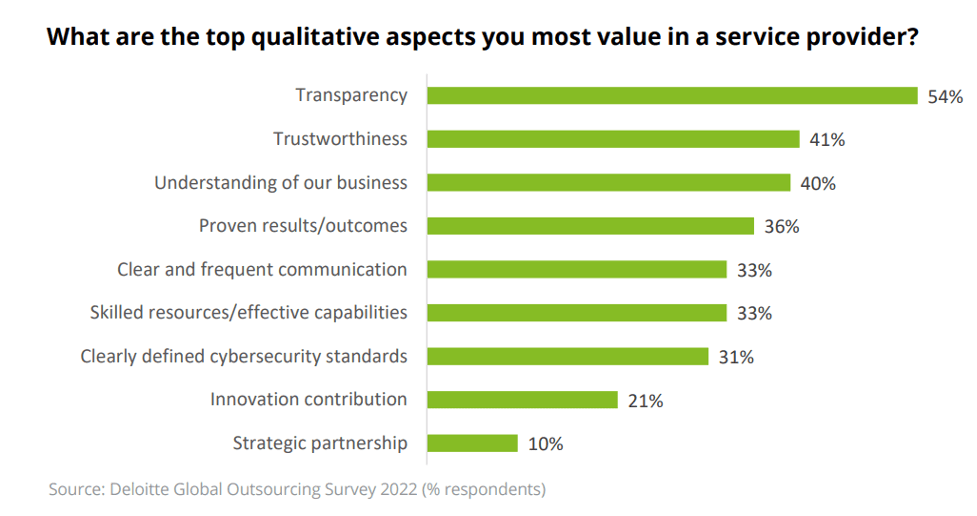The globalized economy made outsourcing a popular strategy for businesses looking to cut costs and speed up product development. However, this approach comes with its risks.
This article discusses communication challenges, quality control problems, and data security concerns that might derive from outsourcing custom software development to offshore or third-party vendors.
Let’s start!
IT Outsourcing in 2023
According to the latest research by Statista, the global IT outsourcing market will grow to $413.7 billion by the end of 2023. This figure highlights the increasing demand for IT outsourcing services.
 Image credit: Statista
Image credit: Statista
The global technology marketplace doesn't stop its expansion. While it penetrates more and more industries, businesses increasingly turn towards IT outsourcing not so much to save costs but to acquire a diversely skilled and knowledgeable workforce. A recent survey by Deloitte found that 72% of all businesses, ranging from startups to large corporations, currently use some form of IT outsourcing services. This figure is expected to rise further in the coming years, resulting in even higher demand. That same report portrays that company executives most often search for trustworthy outsourcing service providers.

Deloitte also highlights the trend of outsourcing entire IT departments rather than just specific projects or tasks. This shift is based on various factors, including difficulty sourcing IT skills internally, the need to access diverse technical skills, and the desire to reduce operational costs. The report states that 56% of businesses shared that they intend to increase their outsourcing efforts over the next few years.
Another trend we are witnessing is the rising popularity of nearshoring, which involves outsourcing IT services to a nearby country instead of far-off locations like India or China. Countries such as Poland, Ukraine, Mexico, and Costa Rica have emerged as preferred outsourcing destinations among companies in North America and Europe. This is primarily due to their geographic and cultural proximity, similar time zones, and affordable yet highly skilled workforce.
Benefits of IT Outsourcing
Here are some of the most significant benefits of IT outsourcing:
- Cost Savings: a primary edge that made the approach so popular. Outsourcing allows for cutting infrastructure-related costs, including hardware, software, and maintenance costs, without sacrificing the quality of IT services.
- Access to Expertise and Experience: access to a team of experts with extensive experience and expertise that the internal team might lack is yet another merit. These experts can solve complex IT problems and help businesses with strategic planning to enable them to align their IT infrastructure with their business objectives.
- Improved Focus on Core Competencies: by freeing up time, resources, and energy, businesses can focus on their core competencies, leading to increased productivity, efficiency, and profitability.
- Scalability and Flexibility: businesses need adapt to changing business conditions, such as growth in demand for a product or service. Delegating some development tasks to third-party vendors means businesses can scale up or down IT services as needed, without worrying about the cost of hiring new staff or purchasing additional hardware or software.
- Improved Risk Management: choosing providers that are well-versed with the latest trends, technologies, and threats in the industry allows for enhanced protection against cyber threats and data breaches.
How can we help you achieve your digital goals?
Get in touchIT Outsourcing Risks
When outsourcing is deemed necessary, businesses must take precautions and choose reputable providers to mitigate risks and ensure quality services. So, before luring on the cost-saving approach to development and its other benefits we listed above, go over the risks it might carry.
So, what are the risks of outsourcing?
Less Control Over the Project
When an organization decides to outsource an IT project to a third-party vendor, they essentially hand over the responsibility of managing the project to the vendor. This means that the organization may have limited control over the project management process, the quality of the work being delivered, and the delivery timelines.
A lack of control over the project can lead to a number of negative outcomes:
- the project may not be completed on time or within budget, leading to financial losses for the organization
- there may also be communication breakdowns between the organization and the vendor, leading to misunderstandings and delays
- the organization may not have full visibility into the project's progress, making it difficult to identify potential issues and risks before they become major problems
- if the vendor fails to meet regulatory requirements or violates any laws during the project, the organization may be held liable, potentially resulting in legal and financial consequences.
Solution tip: setting clear performance metrics and deadlines and conducting regular project reviews can also help to ensure that projects stay on track and meet the organization's expectations.
Hidden Costs
Hidden costs are expenses that are not readily visible or expected during the initial stages of outsourcing. These costs can stem from various sources, such as communication breakdowns, unexpected delays, loss of intellectual property, and contract disputes. Furthermore, hidden costs can incur even after the outsourced function is fully operational, which can further complicate the matter.
One of the main reasons why hidden costs tend to arise is due to the lack of clear and comprehensive agreements between the outsourcing service provider and the client company. Without well-defined terms in the contract, the outsourced function may not deliver the expected performance level, which can result in additional expenses to the business. Even if there is a clear agreement, the act of monitoring and verifying compliance can take time and effort.
Solution tip: make sure all the conditions of your cooperation with the vendor are specified in the contract to save yourself from financial losses.
Miscommunication
Miscommunication is a significant risk associated with IT outsourcing, as it can lead to a range of negative outcomes. For example, misinterpretation of requirements can result in subpar system functionality, leading to errors, delays, and conflicts. Additionally, miscommunication can lead to a lack of transparency and accountability and create vulnerabilities that cybercriminals may exploit.
Solution tip: maintain an open and consistent line of communication between the two parties. This can be achieved by creating a comprehensive set of metrics used to track progress and performance in real time and opportunities for regular reporting in case of critical issues. With exposure to the potential risks of IT outsourcing, proper communication and risk management frameworks are crucial to any partnering strategy.
Quality Flaws
If the outsourced vendor doesn’t have the same level of expertise, experience, or proficiency as the in-house IT team, the chances of quality defects or flaws are significantly higher. These defects can lead to problems such as software malfunctioning, system crashes, performance issues, security breaches, and data loss, resulting in financial losses, customer dissatisfaction, and reputational damage to the company.
Moreover, maintaining the quality of outsourced work can be challenging due to communication, collaboration, and coordination issues. There may be miscommunication or language barriers between the vendor and the in-house team, which can lead to misunderstandings and errors in the work delivered. Additionally, the lack of face-to-face interaction and cultural differences can lead to conflicts and delays that affect the quality of the work.
Solution tip: conduct thorough due diligence and assessments on the vendor's quality processes, capabilities, and performance metrics to mitigate the risk of quality flaws in IT outsourcing.
Management Challenges
Coordinating and managing a remote development team can be complex and time-consuming. Outsourcing firms may need to develop specialized skills to handle this situation and ensure effective communication with each vendor. Maintaining control over project timelines, quality assurance, and issue resolution is increasingly challenging when outsourcing.
Other management challenges that can emerge include discrepancies in project goals, cultural differences, and legal and regulatory compliance issues. To minimize these risks, outsourcing firms can implement various strategies such as better communication, more robust vendor management processes, and clear project goals and performance metrics.
Solution tip: overcoming these challenges requires effective communication, careful vendor management, and a solid understanding of the outsourcing project's goals and requirements.
Security Concerns
Outsourcing IT services can place sensitive data and confidential information in the hands of third-party vendors whose security measures may not be as robust as those of the parent company. In case of a data breach and a loss of sensitive information, your company may face negative publicity and loss of customer trust.
Moreover, data privacy regulations such as the EU's General Data Protection Regulation (GDPR) and the California Consumer Privacy Act (CCPA) impose significant penalties for non-compliance, exposing organizations to financial risks. Non-compliance by outsourced vendors can result in hefty fines on top of the damage to reputation and customer trust.
Solution tip: ensure vendors undergo rigorous evaluations of their security policies, protocols, and infrastructure before being granted access to sensitive company data. The vendor's security practices should align with industry standards, such as ISO 27001, SSAE 16, and HIPAA. Regular security assessments and monitoring of outsourced vendors should also be done to ensure ongoing control over data security.
How can we help you achieve your digital goals?
Get in touchData Privacy Issues
One significant factor contributing to the data privacy issues in IT outsourcing is the inadequate contractual arrangements between the company and the service provider. Most outsourcing agreements focus more on the technical aspects of the services to be provided rather than the data privacy aspects. This oversight creates a vacuum that can be exploited by the outsourcing providers for unauthorized access to the company's data and misuse of sensitive information.
Most service providers often use subcontractors to deliver some of the IT services, which creates a complex chain of custody for the company’s data. This complexity makes it difficult to hold the outsourcing providers accountable for any possible data breaches.
Solution tip: establish comprehensive contractual arrangements focusing on data privacy and ensure transparency and accountability within the outsourcing supply chain.
Lack of Domain Expertise
This risk arises when the outsourcing vendor lacks the knowledge and experience to understand the nuances of the client's industry or niche domain. Domain expertise is crucial because it enables the vendor to anticipate the client's needs, understand the business context, and deliver effective solutions that align with the objectives of the enterprise.
When outsourcing IT projects, the lack of domain expertise can have serious consequences, including project delays, cost overruns, and quality issues. The vendor may struggle to correctly interpret the client's requirements, leading to a mismatch between the expected and actual deliverables. In the worst-case scenario, the outsourcing vendor may make critical mistakes that damage the client's brand or reputation and even lead to legal liability.
Solution tip: choose outsourcing vendors who possess expertise in your domain, have experience working with similar clients, and have a track record of delivering high-quality solutions.
Final thoughts
Stay up-to-date with the latest trends and insights in the world of software development. From the latest tools and technologies to the best practices and methodologies - our blog covers it all.
Take your own software development efforts to the next level.







